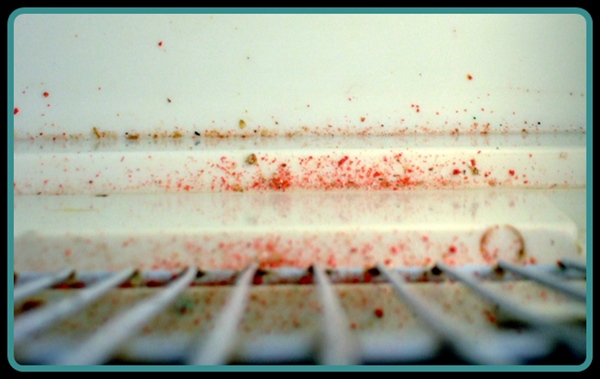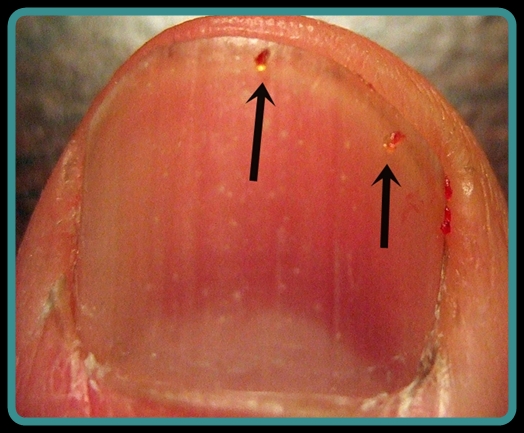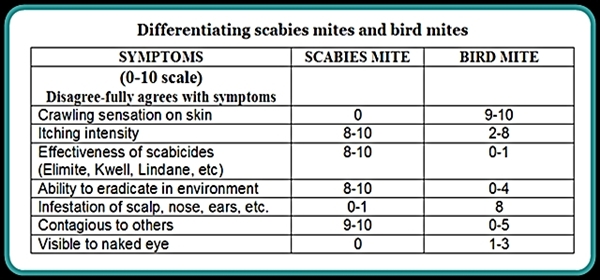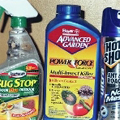“Dedicated to finding effective solutions for bird mite infestations of humans and their environment, encouraging those afflicted, facilitating research and a better understanding of human parasitosis.”
Frequently Asked Questions
Q: Why are these bird mites so hard to get rid of in the home?
A: A home invasion can often involve hundreds or thousands of mites when a bird’s nest has recently been vacated. Mites are very small but very tenacious. These are parasites which have evolved over millions of years, and are very adaptable to a changing environment. Since they need a host mammal to survive, they will do whatever it takes to ensure future generations, including parasitizing other types of mammals, such as humans. It is documented that D. Gallinae can live for up to 9 months without a host.
Q: Why are these mites so hard to see, I can feel them crawling and biting, but don’t see them?
A: A mature bird mite is only about .5 mm or less, and the immature mite is even smaller. Many people state that they are not very easy to see without magnification.
Q: How can I tell which type of bird mite it is?
A: The only way to get a positive ID is to have an entomologist (acarologist) view them under a microscope. Short of that, there are a couple of differences that some may find helpful. If the mite is very tiny and whitish and occasionally seen as crimson red, then it most likely is D. Gallinae, the ‘red mite’. If seen as blackish, it would more likely be O. Sylvarium, O. Bursa, or O. Bacoti. This family of mites tend to be a bit larger and darker than D. Gallinae.
The tell-tale signs of the ‘red mite’, D. Gallinae; with hundreds of bird mites located in the bottom of a cockatiel bird cage. Normally, indoor pets are not affected by bird mites, but after a home invasion, then pets are prone to problems; as this domesticated bird currently is. Symptoms include increased agitation and spending a lot of time in self-cleaning. In some birds this can include anemia, from blood loss, and even death.
Q: Why am I the only one bothered by them in our home?
A: It is not well understood how these mites select a host, but they are very tenacious and often content with parasitizing one individual in the home. This could possibly be due to the pheromones they use to communicate with others, as they tend to swarm the host mammal and crawl or bite in large numbers.
Q: I don’t get many bites, just a lot of crawling on the skin and around my mouth and nose, especially at night. Is this typical?
A: Many report that the mites crawling on the skin at night is the worst aspect to this affliction. The immature mite does NOT need blood, and so will not bite readily. It is thought that the slow crawling on the skin is due to the immature mites. This is also why they are so difficult to see without magnification. Once the mites are invading the mouth, ears, etc., they could very well be getting their blood meal internally and there would be no need for them to penetrate the skin in order to feed. Consequently, very few bites.
Q: Do bird mites fly? Sometimes when I enter a room or get in my car, I can feel them landing on my face?
A: No, bird mites do not fly, as they do not have wings. However, since they are so small and so aggressive when a host is detected, then can float down from the ceiling and other places and land on the person. There are rare reports from some that the bird mite infestation first started outdoors, from being near a tree that was infested. Apparently, the mites would float down and land on the individual and they would then unknowingly transport them indoors.
Excerpt from a Michigan State University “Pest Management Manual”, Chapter 3: Mites and Tick…”Some mites have evolved to become important ectoparasitic pests of animals. Some species of mites have even become endoparasites, invading the ears, bronchi and lungs, nose and other tissues of animals.”
Q: Will others I come in contact with be bothered by these mites?
A: There are some who have reported others where eventually infested by being in contact with the infested person. The level of intimacy among people may also be a determining factor. However, there is no way of knowing who will or won’t have problems from these mites. What is predictable is that if the infestation in the home cannot effectively be dealt with, bird mites will eventually infest the automobile, work environment and other places where people spend much of their time.
Q: What are some of the symptoms of an internal mite problem?
A: Some with a prolonged bird mite infestation in the home eventually have problems with the mites becoming internal for at least part of their life cycle. Some symptoms include: a productive cough with white phlegm in the morning, itching ears and eyes, sneezing and coughing when the mites are in the nose/mouth, and men may wake up with painful erections in the night when the mites are in the urethra. Long-term effects include joint aches, mental fatigue, lose of weight, and other symptoms both subtle and obvious. Some symptoms may be directly related to the mites and their toxins and other symptoms may be related to dealing with stress for a long time; which can affect the person’s immune system.
Close up photo of blood engorged mites extracted from a human ear. Likely D. Gallinae, as they are normally opaque and very small but become crimson red and easier to see after feeding on a blood meal.
Q: Which chemicals (miticides) seem to work the best?
A: We know what does not work; and this includes Pyrethrin and Permithrin, and many of the other ‘thrins’, especially at the low level of active ingredient in most over-the-counter bug sprays. Bayer’s Beta-Cyfluthrin is one of the more effective chemicals available. Using a variety of chemicals is often more effective than relying on one specific chemical for a long period of time. Adding an IGR may also be more effective in the long run. For home fumigation, some have had success with Vikane gas, when used at a 10x concentration. But others have stated this was not very effective; either from the level of chemicals used by the PCO, or possibly due to application errors. Non-toxic products, such as Orthoboric Acid (cockroach powder), and cedar oil, have also been used successfully by some with a bird mite infestation.
Q: Why don’t we see them on the glue boards that the PCO placed in the home?
A: Bird mites are very small and normally opaque and so these will not be readily seen on glue boards. And mites would normally not be attracted to glue boards. They tend to hide during the day and congregate near the host mammal at night. You may have better luck using a hot pan of water in a darkened room, as detailed on the ‘strategies’ webpage. Some are able to more easily see them with a black light in a darkened room.
Q: Will changing my diet, or taking supplements help with this?
A: The short answer is probably not. We do know that mite populations tend to be higher on mammals with a weakened immune system, so it can be helpful to maintain a healthy diet and lifestyle. But there are no reports of ‘cures’ just from taking garlic, or other herbs, etc. Although some have reported a decrease in symptoms with these and other sulfur products. Also, some have noted that parasites tend to thrive in a high carb/sugar environment, and cutting back on these processed foods may help some. The intestinal cleanses that claim to help, are meant for those with intestinal (GI) parasites. Bird and rodent mites do not strictly live in that environment and these cleanses would probably be of little benefit.
Q: Why aren’t doctors and dermatologists more aware of this affliction?
A: Unfortunately, ‘ectoparasites’ are not part of their education and training. Except for the scabies mite, very little is known by the medical profession regarding skin parasites and human parasitosis. It is a specialist, called a ‘parasitologist’, who best understands the interaction of mites and mammals. And they normally study them in relation to animals not humans. Researchers who do study human parasitosis are few and far between.
Q: Isn’t there something more that can be done?
A: Many of us have been asking this question for a long time. There are many things that can be done on a daily basis, as listed on the ‘strategies’ webpage, but there are no simple answers. It is just a lot of hard work!!! As we gain a better knowledge and understanding of parasites and their behavior, then we can find more effective treatment options. And as we find things that are successful and then share this knowledge with others, the easier this will be for all of us who deal with this.
Q: Are there many success stories, most of the posts on the forum are long-standing problems?
A: Yes, there are some who are successful early on with this. It usually depends on how quick the diagnosis is made, and how aggressive the person is with eradication. Also, those who can more easily see the mite, such as with the NFM, tend to have better (and quicker) success, than those who cannot see them, as with D. Gallinae.
Q: Is this just a recent phenomenon, or have bird and rodent mites plagued humans for a long time?
A: There is not a lot of older medical literature regarding mites affecting humans, except for the scabies mite. However, some who had symptoms of unidentifiable rashes and itching may have been dealing with a mite affliction. For example, people with poor hygiene were often labeled as having ‘cooties’, as they would often itch and have rashes from unidentified bug bites, and this could very well have been from mites. The symptoms often were attributed to fleas, lice, etc.; and there is no way of knowing if some of these were actually mites, either bird mites or rodent mites. As our research and knowledge improves, so will our understanding of human parasitosis.
Recommended Treatment Provider
We recommend you use a licensed professional to address a bird mite problem. Don’t wait or the problem will get much worse and more expensive to treat. We have a list of pest control companies that are specifically qualified to treat bird mites.
- They come to your house for no charge and give a free estimate.
- Even if you decide not to use them, you get free professional advice.
- Most pest control companies have never dealt with bird mites before. You need to use a bird mite specialist.
Follow this link to find a Qualified Local Exterminator near you.
Also, many of our readers have followed up with (or used outright) natural solutions and pesticide-free, such as on our Treatments Protocols page Follow this link to that page.
Natural and DIY Solutions
In addition to local exterminators, we offer a list of other natural, non-pesticide and/or do-it-yourself products that we have found helpful on our Treatments Protocol page. Follow this link to the Treatments Protocols page.
“So I have been allotted months of futility, and nights of misery have been assigned to me. When I lie down I think, ‘How long before I get up?’ The night drags on, and I toss till dawn. My body is clothed with worms and scabs, my skin is broken and festering.”
Job 7:3-5








